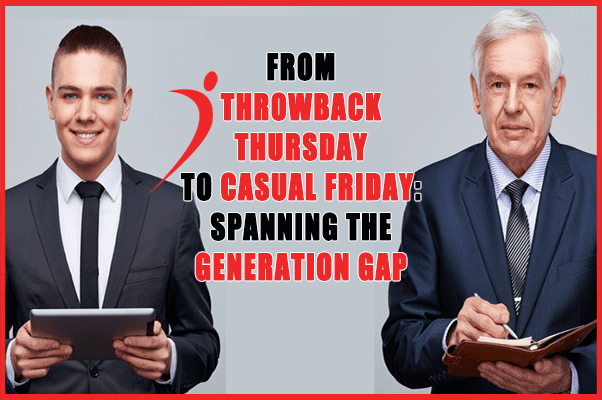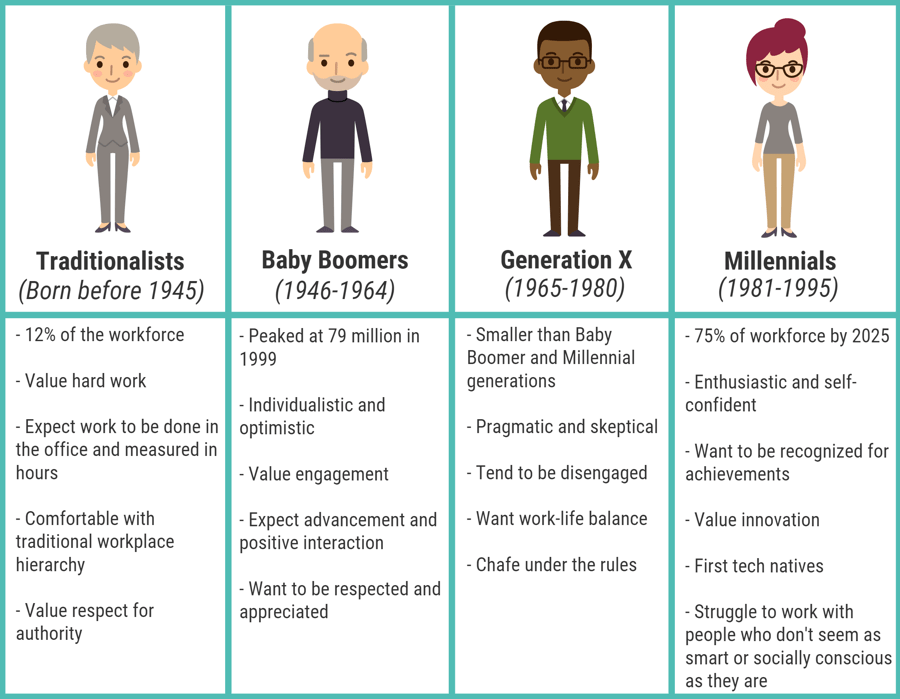
Scroll through any Facebook feed and you’ll eventually see them—those memes that highlight generational differences in sometimes humorous, sometimes thought-provoking ways. “Throwback Thursday” photos might be relevant if you remember a world where cassette tapes, rotary dial telephones, and embarrassing hairdos were the norm.
But sometimes the goal isn’t just a walk down memory lane. It’s to highlight how things—and people—were different back then. The infamous photo of kids staring at their smartphones under a Rembrandt painting has become an icon of the generational struggle—despite the fact that the kids were, in fact, researching a school assignment related to the art.
What’s the point?
It’s that perceptions shape reality, whether you’re talking about kids in a museum or colleagues at work. Perceived generational differences and motivating influences alter the way we view those around us and can affect the way we work together.
Differences: Strength or Weakness?
Whether you love Millennials or feel exasperated with them, you have to admit that they view life differently from previous generations. Older workers may sometimes feel like a Throwback Thursday employee trying to navigate a Casual Friday workforce. And if you are a Millennial, you may find it difficult to “get” the perspectives of those older than you.
From work-life balance to whether or not it’s okay to check Facebook on the clock, ideas about what’s acceptable have changed dramatically over time. Let’s take a quick look at what the generations in today’s workforce expect on the job and how diversity recruiting can help:

Different perspectives can and should represent strength to an organization. They help us identify blind spots and meet widely varying needs with diverse solutions. Unfortunately, our differences often drive us apart rather than bring us together. Millennials scoff at the tech ignorance of Traditionalists. Gen Xers dismiss the entitlement of Millennials. Traditionalists criticize Baby Boomers for not respecting authority.
It all boils down to a disjointed workforce that struggles to work as a team.
But it doesn’t have to be that way.
How to Bridge the Generation Gap
The truth is that while different generations have different communication styles, expectations, and relationships with authority, they also share many traits in common. So how can you create a work environment that brings people together instead of driving them apart?
- Understand what motivates people. One-size-fits-all reward and recognition programs don’t work. Period. It doesn’t matter whether the differences center on age or some other factor—people want different things.
- Build your reward program and management style around motivating factors. Millennials rarely respond well to top-down management styles, while traditionalists may scoff at gamification programs that award badges for accomplishments. Understand and respect the differences among workers, and build recognition of those differences into your workplace interactions, response strategies, and reward systems.
- Identify commonalities. While generation gaps do exist, different age groups also have many things in common. For example, everyone values feedback and wants to be included in company growth strategies. Everyone wants his or her ideas and opinions to be heard. Find ways to leverage these commonalities as you build your teams so that you can benefit from the different perspectives of each generation.
- Create cross-generational teams—The positive traits of each generation can inspire team members. Look for ways to bring out those positive traits and channel them toward shared goals. Don’t fall into the trap of catering to the needs of one group at the expense of others.
Practical Ideas for Engaging Every Generation
All these things sound great in theory, but how can you actively incorporate them into your workplace? Here are just a few ideas:
- Use different communication styles to reach different generations. Cater your communication strategy to the preferred styles of the people you’re speaking to when possible (letters, personal notes, in-person meetings, e-mail, blogs, texts, etc.).
- Rethink how and where work is done. Look for opportunities to incorporate flexible work arrangements, especially for the generations that value those opportunities most.
- Create meaningful standards of productivity. Productivity isn’t always about the number of hours an employee spends at the office. Your most productive employees may work faster and therefore get finished sooner than others, so find ways to recognize those accomplishments.
- Invest in employees. Mentorships and development opportunities help both top performers and new hires feel engaged and valued on the job.
- Give young workers meaningful projects. Don’t just give them all the busy work. Millennials want to feel like their work matters or they’ll find a job somewhere else.
- Introduce cross-generational mentoring. Every generation has something to offer. Millennials have tech skills and interpersonal relationship skills that could benefit everyone on the team. Boomers bring a deep understanding of the workplace, and Gen Xers keep everyone honest and realistic. Find ways for each generation to share their knowledge and experience with others.
The workplace is changing. Millennials have outpaced Baby Boomers in terms of sheer numbers, and soon they will be the largest group in the workforce. But rather than fearing the changes that are coming, companies can embrace them and use them to build stronger, more connected teams.

